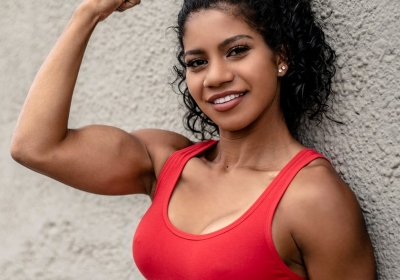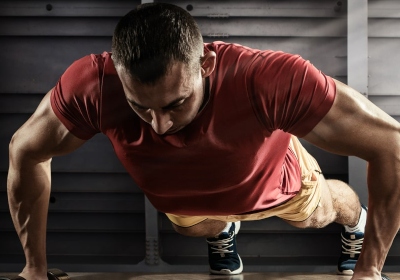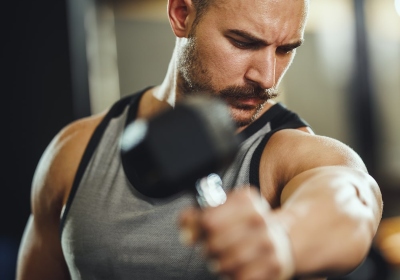VIDEO
Wide Squat Jump
- Arms
- Legs
- Calves
Level:Intermediate
Trainer:Zoey Flores
Equipment:No Equipment
Stand with your feet hip-width appart making a wide squad position. Jump without stopping for a certain period of time.
save to ...
RECOMMENDED FOR YOU
ARTICLES
Biceps is the most famous muscle in the human muscular system, it is approximately one-third of the mass of the shoulder. It is a part of a group of three in the upper arm that works together with each other to lift the arm toward the shoulder. As one of the most visible and impressive parts of the body, “two-headed muscles” are often the gym’s focus.
It is responsible for two main movements of the arm. The first is raising your hand. Those who carry something using their arm are likely to engage them in the process, as some upward force must be applied during the process of carrying and lifting. The second movement, for which they are responsible, is called supination, which rotates the arm from the natural position of the palm down to the palm up.
Biceps are built as a result of injury, which is often achieved through lifting weights such as curls or other types of exercises. As the curls or other exercises are done, the muscles in the arm get minor injuries. These injuries must be repaired naturally. The recovery process, as a natural byproduct, usually leads to growth and strength gains, although this process can take several weeks or months before noticeable results are seen.
Very few exercises work for it without affecting the other parts of the shoulder. Therefore, there is no reason to worry that others in the upper arm might be neglected by focusing on them. Some may focus only on the arm and almost completely forget about the legs or the core.
As one of the most commonly used muscles in the body, the biceps can certainly be damaged. Biceps injuries are not as common as some other types of injuries, there is always a risk, especially among weightlifters. The most common type of injury is damage to the tendon. In this type of injury, It is pulled away from the tendon that attaches it to the arm in a bone also known as the radius. Such injuries occur when they are used suddenly or to a level that they cannot handle.
Training.
Dumbbell Bicep Curls. Stand straight with the dumbbell in each hand and with your feet shoulder-width apart. Once the dumbbells are at your shoulder level, start slowly lower your arms to the starting position. Repeat for the desired amount of repetitions.
Incline Pushup. Place your hands slightly wider than shoulder-width apart on a bench, chair, or couch. And assume a high plank position with your feet together and your body straight from head to heels. Keeping your feet flat and core engaged lower your chest to the bench or chair. Pause. And then push yourself back up to the starting position.
Diamond Knee Pushup. With your knees on the ground place your hands on the ground with your fingers and thumbs touching together creating the diamond shape. This action will engage more your tricep muscle. Then complete a push-up and get back to the starting position. Repeat for the desired number of repetitions.
Pike Pushup. Assume a shorter push-up position, get on your toes and put your butt up, shifting your weights to the front. Bending your arms slowly lower your head, be sure not to bump your head on the ground.
Read more
The arm is one of the most important parts of the body. Arms muscles are only 10-15% of the mass of all muscles in the body. Your arms are not only divided into biceps and triceps but into 20-25 different muscle groups. For example, the biceps is a double flexor muscle attached to the shoulder and elbow. The triceps is a triple extensor muscle that occupies the back of the arm.
In addition, pumping the arms implies an emphasis on the muscles of the forearm and shoulders. For example, when lifting dumbbells while standing, the load falls on the entire upper body - including the trapezoid. The situation is similar with triceps - extensions from behind the head involve the serrated muscles located in the armpit area.
The best arm exercise is the exercise that makes you feel the biceps or triceps work. In order to quickly build muscles, it is not enough to perform lifts of heavy dumbbells, arching the whole body - the workout requires moderate weights, slow speed, and complete muscle control.
For beginners and intermediate athletes, one arm workout per week is enough. On the rest of the training days, these muscles are involved in the work partly- the triceps are involved in push-ups, bench press, and other chest exercises, and the biceps are involved in pull-ups.
The secret to successful arm muscle training is using multi-joint exercises to develop upper body musculature (such as push-ups and pull-ups). In fact, it is impossible to build large arms without having the proper level of development of the back, chest, and shoulders. The frequency of the training also plays a role. Even professionals are not recommended to work with their arms more than twice a week, and the total duration of arms training should not be more than 20-25 minutes - otherwise, overtraining will occur, which negatively affects the growth of muscles. The development of neuromuscular communication - is important too. It is necessary to raise and lower the weight due to the conscious work of the biceps or triceps, and not simply due to inertia. This will help to build up the muscles of the arms as quickly as possible - in the end, they respond quite well to regular training.
Training
Pushup. Put your hands and toes on the mat. Keep your arms straight, but don't lock your elbows. Align your feet making the straight line with your arms and core. Inhaling, bend your elbows and lower your chest to the ground slowly. Straighten your arms to lift your core up, exhaling.
Half Handstand Variation. Begin with the downward-facing dog position. Walk your feet in closer to your hands. Keep your left foot on the ground, lifting onto the ball, and begin bending the knee. Lift the right leg and straighten it behind you. After taking a few hops, jump off the bent leg and lift the straight leg toward vertical. Keep flexing your lifted foot for engagement. Now, try to bring both heels to the wall. Keep breathing deeply while your head is down between your upper arms. Remember to engage your legs and reach up through your heels. Walk your legs down the wall. Then get back to the starting position with your feet on the ground. Make a deep squat and jump out.
Jumps with Dumbbells. Stand with your feet shoulder wide and knees slightly bend, dumbbells in both hands. Bend your knees and squat down engaging gluteus, quads, and hamstrings to push the body up and off the floor. Keep your hands with weights straight down.
Read more
Push-ups, strength exercises, gymnastic elements on rings and a horizontal bar, handstand - all these exercises require strong and flexible wrists. Let’s discuss how to develop your wrist strength and do exercises without pain and discomfort.
The wrist is a movable connection of the bones of the forearm and hand of a person. It is formed by the extended and concave carpal articular surface of the radius and a medially located triangular cartilaginous disc, representing a concave articular surface articulating with the convex proximal (located closer to the body) articular surface of the bones of the first row of the wrist: scaphoid, lunate and trihedral.
The proximal row is connected with the exchange cyst behind the additional exchange wrist joint. The skin row is set in an arch, bent proximally and distally bent. On the long sides of the wrists of the vignutia set up the carpal canal, we will fix the flexor retinaculum. The proximal row is connected with the surfaces of the exchange brush and the distal row. In the proximal row, the dermal cyst can be surrounded by an undisclosed ruffle: for example, it is more like the fate of the unprotected midget steel, which can be easily joined from the trapezoidal and trapezoidal style. The cysts of the distal row, on the other hand, are more rigidly fastened, so that the whole row collapses at once with the pastoral cysts.
Some sports require strong wrists. Wrist strength should be developed in parallel with flexibility. This will help you do exercises that require not only good grip but also joint mobility. Exercises for the wrists are also useful for people who are far from sports. Warming up and stretching the wrists can help avoid tunnel syndrome - the compression of the median nerve between the bones and tendons of the wrist. Warming up will help relieve tension and will be excellent pain prevention.
The number of eight wrist cysts can be divided into two transverse rows (proximal and distal), or into three later colonies.
Training
Bear Crawl Lunge. Move forward by moving the right hand and the left leg with a crawling movement. Just after placing weight on the right hand and left leg, turn the sides and move the left hand and right leg forward. Keep the body pretty low and continue with crawling movements. Imagine that you are crawling beneath a low net.
Half Handstand Variation. Begin with the downward-facing dog position. Walk your feet in closer to your hands. Keep your left foot on the ground, lifting onto the ball, and begin bending the knee. Lift the right leg and straighten it behind you. After taking a few hops, jump off the bent leg and lift the straight leg toward vertical. Keep flexing your lifted foot for engagement. Now, try to bring both heels to the wall. Keep breathing deeply while your head is down between your upper arms. Remember to engage your legs and reach up through your heels. Walk your legs down the wall. Then get back to the starting position with your feet on the ground. Make a deep squat and jump out.
Inchworm Variation. Put your hands on the ground and your feet - on the elevated surface (a bench). Start walking your hands out, as far as you can keeping your legs straight throughout the movement. Make a pause. Walk your hands back up to the starting position.
Read more
In bodybuilding and fitness, the deltoid muscles play a special part. Despite the fact that the muscle area belongs to small groups, it is second only to the biceps in terms of training frequency. The reason lies not only in the importance of the deltoid muscles in the anatomy but also in improving the aesthetics of the figure. Understanding the functions and features of the deltoid bands allows you to maximize the effectiveness of the training process and significantly reduce the injury risk.
The deltoid muscles consist of three heads (bundles):
The anterior head (anterior bundle) attaches to the humerus and is responsible for lifting the arm forward.
The middle head (lateral bundle) is attached to the acromion of the scapula and allows the arm to be lifted sideways.
The posterior head (posterior bundle) is attached to the scapula and allows the arm to be moved backward.
The deltoid muscle covers the shoulder joint. The muscle is thick, triangular in shape, with the base up and the apex down. It consists of large muscle bundles, which fan-like converge at the apex. It starts from the clavicle and scapula and attaches to the deltoid tuberosity of the humerus.
In training the deltoid muscles, it is very important to pump all three bundles equally. This will protect the shoulder joint from injuries.
The deltoid muscle bundles have different functions, so you cannot work them all with just one exercise: you must include at least three movements in your workout.
You must correctly select exercises for pumping the front, middle and rear bundles. Choose one exercise from each category and add them to your workouts.
Shoulders should be trained no more than twice a week (once is enough for beginners), this will allow the muscles to fully recover for the next workout.
Here is some basic exercises for deltoids:
The army bench press or barbell/dumbbell press in standing or sitting position (middle, front).
Bench press from behind the head while seated (middle, front).
Chin-up or 'broach' barbell pull (middle, front).
Lee Heini pulls (back, middle).
Arnold press (front, middle).
Read more
The shoulder muscles are divided into two groups. The anterior group consists of flexors: the coracohumeral, the brachialis, and the biceps brachii. The posterior group includes the extensors: the triceps brachii and ulnar.
The coracohumerals start from the coracoid process of the scapula fuses with the short head of the biceps brachii and pectoralis minor and attaches to the humerus at the level of the upper edge of the brachial.
The brachials start from the lower half of the anterior surface of the humerus and the intermuscular septa of the shoulder and attach to the tuberosity of the ulna and its coronal process.
The biceps brachii has two heads starting on the scapula from the supra-articular tubercle (long head) and the coracoid process (short head). It attaches to the forearm to the tuberosity of the radius and the fascia of the forearm. It belongs to the bicarticular part. Concerning the shoulder joint, the biceps of the shoulder is the flexor of the shoulder, and the elbow is the flexor and instep support of the forearm.
The triceps brachii is located on the back of the shoulder, has three heads, and is a bicarticular. It participates in the movements of both the shoulder and the forearm, causing extension and adduction in the shoulder joint and extension in the elbow.
The ulnar starts from the lateral epicondyle of the humerus and radial collateral ligament and the fascia; it is attached to the upper part of the posterior surface and partly to the olecranon of the ulna in its upper quarter. The function of this is to extend the forearm.
The bundles of the deltoid muscle perform different functions, so it will not work to load them all with one exercise: you will have to include at least three movements in the training. All exercises are divided into three parts: for pumping the front, middle and back beams. Pick exercises from our list below and add them to your workouts. The weight is necessary so that the last repetitions in the approach are given not easily, but without compromising the technique. You can train your shoulder straps both at home and in the gym. But it is necessary to have a bar and a gantry. Weight must be chosen in such a way that in every set it was possible to raise the average 8-10 times. This is how you can increase the volume and mass. If the same goal is set - to increase the strength, to train in the face of more severe conditions. In this case, the number of repeats will be 5-8. The number of reps is 4-5.
Barbell bench press. Take the shell on your chest, bring your elbows forward, tighten your abs, buttocks, legs. Squeeze the bar up, lower it back and repeat. When the bar passes your face, do not lift your chin, but squeeze it in yourself: this way the bar will go along the optimal trajectory. If the projectile remains in front of the body at the top point, and not above it, the load on the lower back increases. Therefore, try to take the barbell behind your head.
Standing dumbbell press. Raise your arms with the selected weight to shoulder level, turn your palms forward with your fingers. Squeeze the dumbbells up and take them slightly behind your head, and then lower them to the starting position and repeat. Do three to five approaches 10-12 times.
Seated Bent-Over Dumbbell Routing. Sit on a bench, tilt your body with a straight back, as far as flexibility allows, hold the dumbbells in your lowered hands. Without changing the position of the body, spread your arms with the taken weight on the sides to shoulder level. Slowly lower the dumbbells to the starting position and repeat.
Read more
SAVE TO ...





